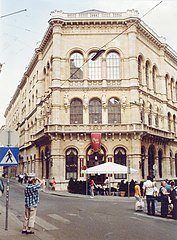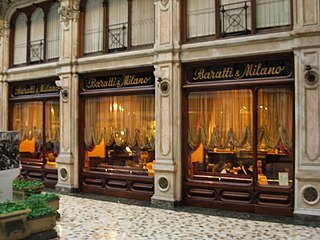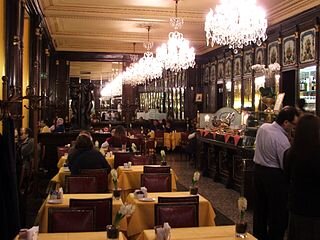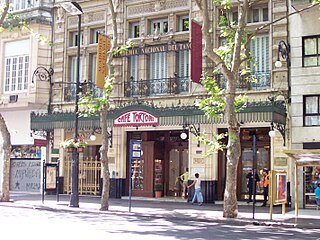Part 3: How old is old when we’re talking coffee shops? (19th Century)
By Perry Luckett, CoffeeMan1
Updated June 18, 2020
Come along as I visit another century in our tour through historic coffee houses—this time with a cozy slide to 19th Century Vienna, Turin (Italy), Buenos Aires, and Budapest.
Coffee café in Vienna’s center has cozy bond to Austrian culture
Café Central exterior. Vitold Muratov / CC BY-SA (https://creativecommons.org/licenses/by-sa/4.0)
Café Central, Vienna (Austria). Colloquially referred to as “the chess school” because organized chess competitions were popular there around the turn of the 19th century, Café Central is inside the Palais Ferstel, which was originally constructed to serve as the Bank and Stockmarket Building. [SP] Built by Heinrich von Ferstel between 1856 and 1860, the whole construction would have cost about 25 million Euro ($27 million) today, thanks to the interior’s use of stucco lustro, leather wall coverings, and wood paneling. [JK]
Café Central front entrance. Николай Максимович / CC BY (https://creativecommons.org/licenses/by/3.0)
As the name suggests, Café Central is the real center of Vienna – not St. Stephen’s Cathedral. The entrance to this coffee and cake lovers’ paradise is on the corner of Herrengasse and Strauchgasse in the first district. The city’s best-known sights and museums and its most exclusive shopping streets—Graben and Kärntner Strasse—are all within easy walking distance. [https://www.cafecentral.wien/en/]
Over coffee, cake, and the odd cigar, some of the world’s greatest poets, philosophers, and storytellers gathered in Vienna’s most attractive coffeehouse. With patrons such as Leon Trotsky, Vladimir Lenin, Stefan Zweig, and Sigmund Freud, Café Central in Vienna served as the stomping grounds for many Austrian intellectuals. Given its spellbinding grandeur, inspired by Venetian and Florentine architecture, it’s easy to see why the literati visited this café often. The façade is adorned with sculptures by the painter Hanns Gasser. [JK]
Café Central Interior. Misaochan / CC BY (https://creativecommons.org/licenses/by/4.0)
Café Central closed shortly after the conclusion of World War II and was not reopened until the building’s renovation several decades later. The shop has operated continuously since its resumption in 1975 and was restored to original grandeur in 2006. [SP] The menu includes a broad selection of classic Viennese dishes, traditional coffee specialties, and sweet treats from the in-house patisserie. You can soak up the historic surroundings as you sample Café Central’s mouth-watering choice of culinary creations. [https://www.cafecentral.wien/en/]
Luxurious coffee house covers your chocolate craving too
Baratti & Milano Caffe, Turin (Italy). This is one of Turin’s most beautiful early Italian coffee houses. It was founded as a cafeteria in 1858 by Ferdinando Baratti and Edoardo Milano with the name “Fornitore della Real Casa” (Supplier of the Royal House). In 1875 it moved to its present location between the Piazza del Castello and the Galleria Subalpina, an area used for part of the infamous Austin Mini car chase scene in the original 1969 production of the film “The Italian Job.” [PB] The owners expanded the property in 1909. [JK]
Baratti & Milano exterior. Enryonthecloud at Italian Wikipedia / Public domain
Baratti & Milano has been the height of café luxury since the late 19th century, and it shows—it is a triumph of gilded upholstery, chandeliers, wooden panels, shiny mirrors, and green marbles. They serve excellent espresso drinks, but hot chocolate is the headliner here—velvety, bittersweet, so dense it could almost stand without a cup. The café even sells a ready-made mix for you to drink at home—not quite so rich as the one in the shop. Most people drink their chocolate in the café, perhaps with a small slice of Torta Baratti. Some then take home a bag of sweets and creamy gianduiotti, Turin’s hazelnut flavored chocolates, from the antique wooden counter by the entrance. [CP]
Baratti & Milano interior. Salvatore Costa from Montesilvano, Italy / CC BY-SA (https://creativecommons.org/licenses/by-sa/2.0)
In 1999, Baratti & Milano became part of a larger company, Elah Dufour, which also owns Novi chocolate and advertises itself as the “sweetest brand in Italy.” The company started in 1982 under businessman Flavio Repetto and now owns four well-established brands of the Italian confectionary industry. The café has maintained its quality under Elah Dufour’s direction because of Repetto’s dedication to quality. In 2007, the Group was awarded an important European prize on product excellence: the European Candy Kettle Award.
Argentinian coffee café one of ten most beautiful in the world
Café Tortoni, Buenos Aires (Argentina). Café Tortoni is straight out of the 19th century. It was founded in Buenos Aires at the end of 1858 by a French immigrant named Touan. it was named Tortoni after the Parisian café of the same name located on Boulevard des Italiens (where the elite of the Parissiense culture gathered in the 19th century). The café itself was inspired by end of century coffee houses.
Café Tortoni street view. Roberto Fiadone / CC BY-SA (http://creativecommons.org/licenses/by-sa/3.0/)
The space the café now occupies was previously the location of the Templo Escocés ("Scottish Temple"), and the Tortoni was on the corner of Rivadavia and Esmeralda. In 1880 it moved to its present location, but had its entrance on the other side of the block in Rivadavia Street. In 1898 the entrance on Avenida de Mayo was opened, and the facade was redesigned by architect Alejandro Christophersen. Then, at the turn of the century, another Frenchman, Don Celestino Curutchet, bought the space and turned it into a hub of artistic activity in the 1920s. [JK]
Curutchet founded Buenos Aires’ Arts and Letters Association, and the café’s basement cellar became the group’s meeting place. [JK] In the basement, La Peña was inaugurated in 1926, which supported protecting arts and literature until its disintegration in 1943. Over the years the café has hosted many renowned people including international figures such as Albert Einstein, Federico García Lorca, Robert Duvall, and Hillary Clinton.
Café Tortoni interior. hummanna / CC BY (https://creativecommons.org/licenses/by/2.0)
UCityGuides selected Café Tortoni as one of the ten most beautiful cafes in the world. [Wiki] Visitors can see why. It has majestic, intricate moldings, a $1.4 million Tiffany glass ceiling, a lot of Tiffany lamps and—like many classic Buenos Aires cafes—smooth, round marble-topped tables. [WA]
The 80-seat basement, called the Quinquela Martin Room or “La Bodega,” works as a stage for jazz and tango artists, and for the presentation of book and poetry contests. The café has conserved the decoration of its early years, has a library, and (at the back) facilities to play billiards, dominoes, and dice. [WikiCT] While here, many tourists take a worthwhile detour upstairs to the World Tango Museum to see the National Academy of Tango’s Belle Époque mansion and tango artifacts stretching back to the birth of the Argentina’s most famous dance.
Wander Argentina says Café Tortoni has become very popular because of the new-found “Instagram effect,” which means it’s sensible to avoid going to Tortoni during peak hours (after work during the week). The place can get overrun by tourists, and the acoustics can make it hard to hold a conversation. Lately so many tourists have visited that a line regularly forms outside the door just to enter the cafe, so those looking for a quick bite to eat should be forewarned.
Café Slavia: coffee and history form a cozy bond
Café Slavia, Prague, Czech Republic exterior. DIMSFIKAS / CC BY-SA (https://creativecommons.org/licenses/by-sa/3.0)
Café Slavia, Prague (Czech Republic). Café Slavia is on the corner of Národní and Smetanovo nábřeží streets, next to the Vltava river. [WikiCS] This 300-seat cafe opened across from the National Theater in 1884 to lure theatergoers for pre- and post-show drinks. It wasn’t long before Slavia earned a reputation as a gathering place for Bohemia’s culture scene, serving coffee to the likes of composer Bedřich Smetana, poet Jaroslav Seifert, and painter Viktor Oliva, whose famous “Absinthe Drinker” now hangs in the cafe above the most-reserved table. Poet and novelist Rainer Maria Rilke regularly spent time in the café. [TC]
Café Slavia, Prague, Czech Republic interior. DIMSFIKAS / CC BY-SA (https://creativecommons.org/licenses/by-sa/3.0)
Slavia was known also for its associations with Prague's dissident community, hosting people such as Václav Havel, who would later become his country's president, and poet Jiří Kolář during the normalization period—after the Warsaw Pact invasion of Czechoslovakia in August 1968 up to the liberalizing changes that began in the Soviet Union and its neighboring nations in 1987.. It was also known as a place for writers, poets, and other intellectuals to meet and discuss their ideas. [Wiki] It’s not hard to imagine these legends huddling around the cafe’s cozy leather booths or window tables, which overlook postcard views of the Vltava river and more distant Prague Castle.
Nowadays, the air is always filled with conversation between Czech businessmen in meetings, students from the next door film school, or bowtie-wearing waiters taking orders for dishes that have been on the menu for 130 years. Traditional cafe society may be a thing of the past, but Cafe Slavia still reflects its bohemian roots. On some mornings people sit with the newspaper and take their time, absorbing the history captured in its walls. [TC]
Lovely Budapest coffee house covered rich and poor alike
New York Café, Budapest (Hungary). Calling itself “the most beautiful café in the world” may sound snobbish, but the New York Café in Budapest, Hungary, lives up to the claim. The New York Life Insurance Company constructed the café within the New York Palace in eclectic Italian Renaissance-style and opened it on October 23, 1894.
At the turn of the 20th century the New York Café was the most beloved coffee house in Budapest. It was a popular place among writers and editors, and the most influential newspapers were edited here—upstairs in the gallery. After World War II, the once famous café fell into disrepair and it served as a sporting goods shop. Although the café reopened in 1954, under the name of Hungária, it waited another 50 years before being restored to its former glory. [HGT].
Near entrance of New York Palace Hotel and New York Café. Fred Romero from Paris, France / CC BY (https://creativecommons.org/licenses/by/2.0)
After the collapse of communism, the Italian Boscolo Hotels chain bought the structure in February 2001. They renovated the building and reopened it in May 2006 as a luxury hotel, with the renovated café on its ground floor. High-vaulted ceilings and intricate moldings make visitors feel like they’re in a museum. [JK] The menu also recalls the cuisine of the Austro-Hungarian Monarchy. Classic dishes such as beef goulash, fishermen soup, chicken leg paprikash-style, wiener schnitzel, and grilled foie gras are served along with famous desserts such as Dobos, Sacher and Esterházy cake. [HGT]
New York Café interior. Yelkrokoyade / CC BY-SA (https://creativecommons.org/licenses/by-sa/3.0)
The New York Café has lived through many eras, political systems, and historical turning points. Still, it has always been reborn, sparkling and occupied by those who longed for its comforts: artists, members of the nobility and commoners alike. Gabor Foldes, PR & Marketing Manager for the New York Palace hotel, says the café is “the starting point of Hungarian modern literature. All of the most famous writers and poets came here. It was crowded with writers. We are very proud of that." [HGT]
New York Café clocks. Gzzz / CC BY-SA (https://creativecommons.org/licenses/by-sa/4.0)
Hungarian food critic Andras Jokuti reminds readers that the New York Café’s luxurious décor didn’t make it a coffee house only for the rich. It was a meeting point for poor artists. Jokuti says "They just went there in the hope there would be some nice rich people who would offer them a meal. For example, for a nice poem for their wives, or any other services, or just to help form a letter." This brought about the birth of a literature movement known as "Nyugat," which took its name from a periodical that published poetry and prose by Hungarian writers. [HGT]
Today, the renovated building’s significance has outgrown Hungary in terms of special memories, experiences, and things to see. In 2011, it was awarded the prestigious title of Most Beautiful Cafe in the World, a status the owners have striven to maintain ever since.
Though our history as a company is much shorter, Koffee Kompanions also strives for beauty and effectiveness in our products, which have kept coffee or tea cozy hot for our customers since 1998. Come see us at www.koffeekompanions.com for a French press cozy, tea cozy, cup wrap, cup cap, cup cozy, or ice cream pint koozie that makes your beverage drinking (and ice cream eating) a pleasure.
References
Peter Baskerville, The world's most historic coffee houses, https://bit.ly/2xsn19P , Feb 14, 2013. [PB]
Beanbox.com, “The 5 Oldest Coffee Houses in the World,” https://bit.ly/35TqyKV (date unknown) [BB]
Tatiana Cirisano, “Café Slavia’s 132 year history,” The Prague Visitor, https://www.praguevisitor.eu/cafe-slavia/, November 8, 2016. [TC]
Tamara Hardingham-Gill and Lianne Turner, “The extraordinary elegance of Budapest's New York Café,” https://cnn.it/2zaOTjh, December 10, 2019. [HGT]
Jill Krasny, “12 Stunning Cafés Every History Buff Needs to Visit,” TravelandLeisure.com, March 22, 2017. [JK]
New York Café website, https://bit.ly/2LGKPtK , 2015. [NYCW]
Samuel Parker, “The Five Oldest Coffee Shops in the World,” https://bit.ly/2KcdhDc , Feb 11, 2020. [SP]
Carla Passino, Three of the Best Cafés in Turin, https://bit.ly/2LGD5rS , September 11, 2008 [CP]
Wander Argentina, “Grand Café Tortoni: An Iconic Avenida de Mayo Café,” https://bit.ly/2ZgiEKo , May 15, 2020. [WA]
Wikipedia, Café Slavia, https://en.wikipedia.org/wiki/Caf%C3%A9_Slavia, October 30, 2019. [WikiCS]
Wikipedia, Café Tortoni, https://bit.ly/2WFFNEa, December 18, 2019. [WikiCT]












